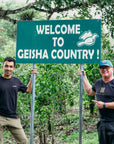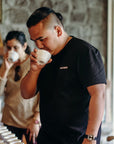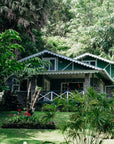Three generations of Jansons run the operations of Janson Coffee today. Kai and Jannette Janson, both from the second generation and Miguel, Janette’s son, are at the forefront. Their coffees have been awarded and auctioned several times at the Best of Panama, and are often featured by coffee champions on the world stage.
2023 has so far been a hallmark year for @kaijanson, @jannettejanson, and the rest of the Janson coffee family as they were part of that dream team who took home the top trophy at the 2023 World Barista Championship, with a Janson Geisha at the core of the winning routine, as well as podium finishers at the 2023 World Brewers Cup.
At the Best of Panama 2023, Janson Geisha Natural ranked 3rd, while Geisha Washed placed 5th.
Their family’s work in coffee began in the mid-1980s when the first generation realized their land’s potential for coffee cultivation after receiving advice from agricultural engineers. And it was in 1990 that Janson Coffee was officially established by Michael, Carl, Ricardo†, and Peter Janson.
They were inspired by their father’s dedication to hard work, quality, and love for their land. Since the company’s founding, their vision has been to produce high-quality specialty coffee consumed and enjoyed in Panama and abroad. Their father was Carl Axel Janson, a Swedish immigrant who acquired and established the original Janson hacienda, a cattle farm, in 1941.
As a family enterprise, they continue to be driven by the passion to produce excellent coffees while preserving their land and improving the quality of life of their collaborators and their respective families.
Two coffee plantations, spanning 100 hectares combined, comprise Janson Coffee. Both are located on the Talamanca Mountain Range, on the inclines of the Tizingal and Baru volcanoes. Different varieties are cultivated on them — Catuai, Caturra, Pacamara, and Panama Geisha.
Hacienda las Lagunas is in Tierras Altas, the High Lands District, in Volcan. Its name comes from the wetlands and lagoons in the vicinity. Located west of the Barú Volcano, Hacienda las Lagunas is rich in volcanic soil and has access to natural springs. Areas of natural reserve surround the different lots in the coffee farm and act as natural barriers. They also serve as essential habitats for a diversity of birds and wildlife.
Meanwhile, Los Alpes, named after the Swiss Alps sits on the slopes of the Tizingal volcano, amid the Talamanca Mountain range in the westernmost part of Panama, northwest of the Barú Volcano and adjacent to the La Amistad International Park, which is a natural reserve and UNESCO World Heritage Site. This park crosses the Panamanian border into Costa Rica and shelters rich biodiversity, including the famous Quetzal bird.
Raising the Energy Around Coffee
At our February 2023 Producer’s Talk, when Kai shared his thoughts on how he sees specialty coffee evolving, we gained insight into the impetus for the innovations at Janson Coffee that result in the fascinating flavor profiles in our cup. What he said also lightly touched on the consumer's role in shaping the future of specialty coffee.
He told us, "It's an amazing ride — to see coffee grow and the energy around coffee… Our intention is, how do you create a coffee that is so fruity that you know it's a natural, and so powerful you know it's anaerobic, and so clean and gorgeous that it's like a classic washed — all in one cup, and at different points in the cup…if you're paying attention, you'll see that." He also mentioned that brewing plays a large part in upholding quality.
When we asked what's on the horizon for Janson Coffee, Kai shared that their goal is to keep raising the energy around coffee. We took this to mean: continuing to chase excellence in coffee quality and keeping everyone excited about it by creating genuine relationships and fun shared experiences with the coffee people they encounter.












